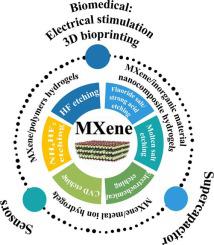European Polymer Journal ( IF 5.8 ) Pub Date : 2022-02-08 , DOI: 10.1016/j.eurpolymj.2022.111063 Can Zhou 1 , Xiaohan Zhao 1 , Yingshuo Xiong 1 , Yuanhan Tang 1 , Xintao Ma 1 , Qian Tao 1 , Changmei Sun 1 , Wenlong Xu 1

|
Two-dimensional (2D) transition metal carbide/nitride (MXene) has been a hot topic of research since it was proposed in 2011. Etching methods to obtain MXene from MAX phase have been continuously investigated. The excellent hydrophilicity, conductivity and tunability make MXene widely used in electrochemistry. In addition, the development of wearable sensors has promoted the research of conductive hydrogels, and improving the performance of conductive hydrogels is still an area of effort for researchers. Therefore, the incorporation of MXene into hydrogel systems will result in significant improvements in performance. This paper reviews the etching methods of MXene, the synthesis strategies and applications of MXene conductive hydrogels, and provides an outlook on the future development of MXene and MXene conductive hydrogels.
中文翻译:

MXene的蚀刻方法及MXene导电水凝胶的应用综述
二维 (2D) 过渡金属碳化物/氮化物 (MXene) 自 2011 年提出以来一直是研究的热点。从 MAX 相获得 MXene 的蚀刻方法一直在不断研究。优异的亲水性、导电性和可调性使 MXene 在电化学中得到广泛应用。此外,可穿戴传感器的发展推动了导电水凝胶的研究,提高导电水凝胶的性能仍是研究人员努力的方向。因此,将 MXene 结合到水凝胶系统中将显着提高性能。本文综述了 MXene 的蚀刻方法、MXene 导电水凝胶的合成策略和应用,并对 MXene 和 MXene 导电水凝胶的未来发展进行了展望。


















































 京公网安备 11010802027423号
京公网安备 11010802027423号